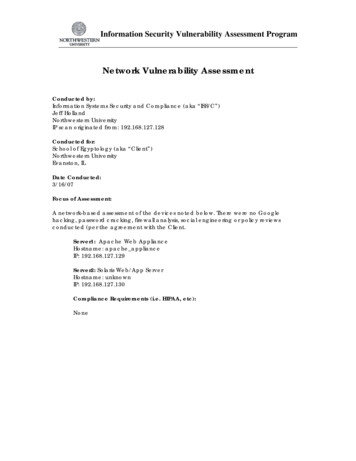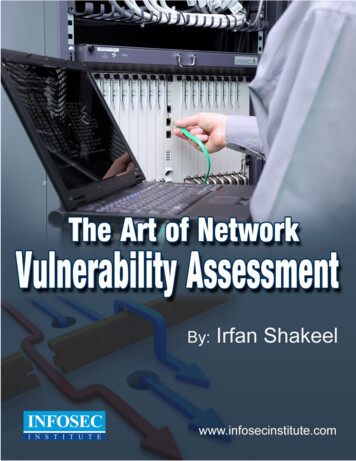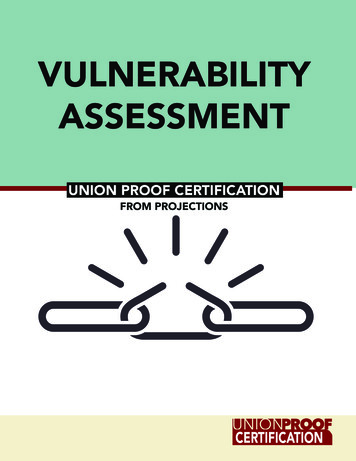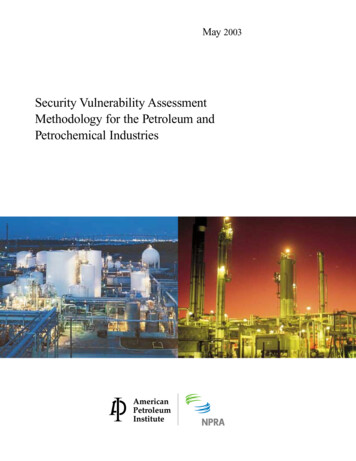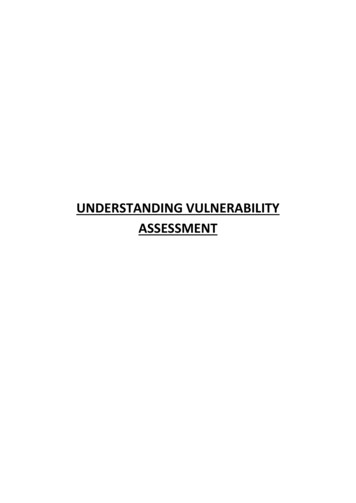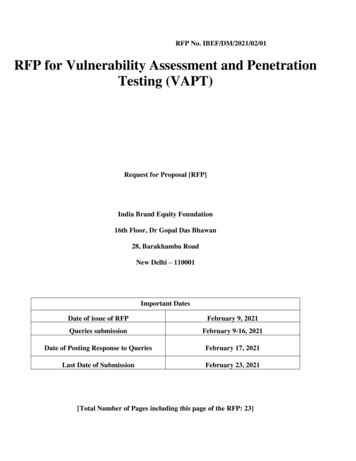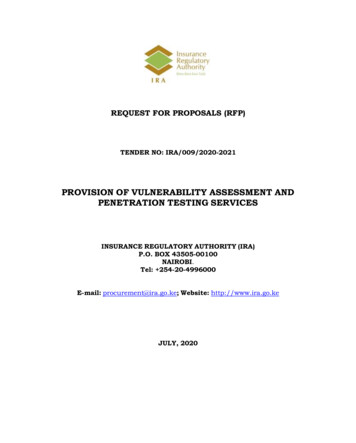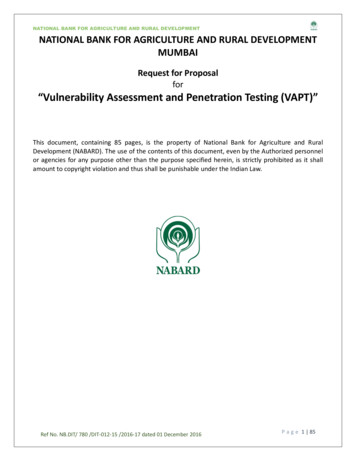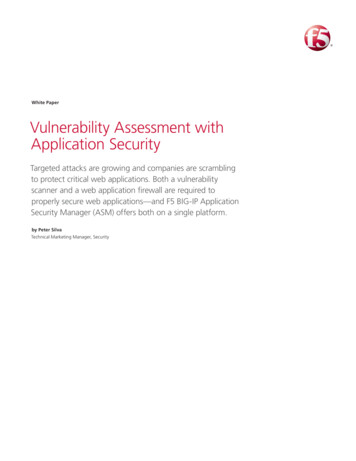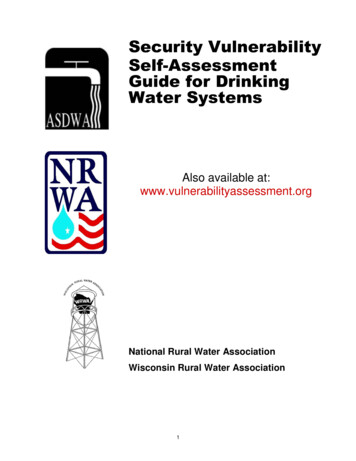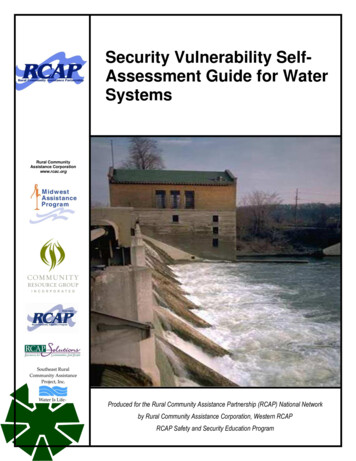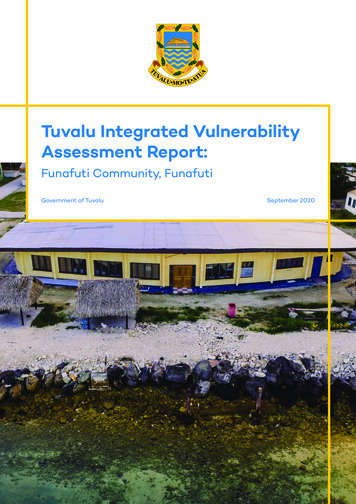
Transcription
Tuvalu Integrated VulnerabilityAssessment Report:Funafuti Community, FunafutiGovernment of TuvaluSeptember 2020
This report is the result of a joint initiative between the Department of Climate Change and Disaster(DCCD) of the Government of Tuvalu and the NAP Global Network. Government of Tuvalu, 2020All rights for commercial/for profit reproduction or translation, in any form, reserved.Original text: EnglishAuthors: Ian Hay (international consultant), Tomu Hauma, Tuitala Lasifo, Saamu Tui (National IVAConsultants), and Joana Latasi (Tuvalu Integrated Vulnerability Assessment Database Officer).Cover image: ?Recommended citation: Government of Tuvalu. (2020). Tuvalu Integrated Vulnerability AssessmentReport – Funafuti community, Funafuti. Government of Tuvalu and NAP Global Network/International Institute for Sustainable Development (IISD).AcknowledgementsThe Tuvalu Integrated Vulnerability Assessment Report – Funafuti community was developedthrough the United States In-Country National Adaptation Plan (NAP) Support Program in Tuvalu,which is implemented by the International Institute for Sustainable Development (IISD), host to theNAP Global Network Secretariat.About the NAP Global NetworkThe NAP Global Network was created in 2014 to support developing countries in advancing theirNational Adaptation Processes (NAPs), and help accelerate adaptation efforts around the world. Toachieve this, the Network facilitates sustained South–South peer learning and exchange, supportsnational-level action on NAP development and implementation, and enhances bilateral supportfor adaptation and climate-sensitive sectors through donor coordination. The Network’s membersinclude participants from more than 140 countries involved in developing and implementing NationalAdaptation Plans, as well as 11 donor members. Financial support for the Network has been providedby Austria, Canada, Germany and the United States. The Secretariat is hosted by the InternationalInstitute for Sustainable Development (IISD). For more information, visit www.napglobalnetwork.org.Any opinions stated herein are those of the author(s) and do not necessarily reflect the policies oropinions of the NAP Global Network, funders or Network participants.United States In-Country National Adaptation Plan (NAP) Support ProgramGift of the United States GovernmentFinancial support provided by:Ce projet a été réalisé avec l’appui financier de :Implemented by:Initial funding for the Network also provided by:
Table of Contents1.0 Introduction – Background and context for the Integrated Vulnerability Assessment andReporting Process. 11.1 Objectives of This Report. 11.2 What Is the IVA framework and Data Collection Approach?. 11.3 IVAR Process Methodology and Linkage to the NAP Process.52.0 National and Location Summary. 82.1 National Context.82.2 Climate and Climate Change in Tuvalu.82.3 Funafuti Community Summary.83.0 Funafuti Community IVA Results and Analysis. 103.1 Top Five Vulnerability Issues.103.2 Sector-Level Scores and Priorities. 153.3 Summary and Prioritisation of Results and Conclusions.244.0 Results of the TWG Review. 344.1 Results of the TWG’s Investigations.365.0 Community Validation of IVA Results and TWG Feedback.425.1 Community Validation of IVA Results.425.2 Community Validation of TWG Feedback.426.0 Summary of TWG and Community Feedback. 456.1 IVA Validation.456.2 Emerging Themes. 467.0 Conclusions and Next Steps. 48References.50Appendices.51A1. Technical Working Group Participants. 51A2. Community Information and Feedback Session Agenda.53A3. Community Information and Feedback Session Participants.54Tuvalu Integrated Vulnerability Assessment Report: Funafuti Community, Funafutiiii
1.0 Introduction – Background andcontext for the Integrated VulnerabilityAssessment and Reporting ProcessThis report captures the results of the Integrated Vulnerability Assessment (IVA) as conductedin the Funafuti community, Funafuti Atoll, Tuvalu. It includes the outcomes of the technical andcommunity review stages of the IVA process.1.1 Objectives of This Report Communicate and analyse key results of the IVA in a user-friendly way. Inform the national adaptation planning process by providing a gender- and youthresponsive evidence base for sub-national vulnerabilities and community-identifiedadaptation priorities. Reinforce the bottom-up and top-down approach to assessment, prioritisation, andplanning to institutionalise national to sub-national linkages (vertical integration). Ultimately, inform evidenced-based adaptation planning, helping prioritise and directinstitutional responses at every level of governance within Tuvalu, including for externalfunding.1.2 What Is the IVA framework and Data CollectionApproach?1.2.1 The IVA Framework and ApplicationThe IVA systematically examines how environmental and developmental changes affect localcommunities and the subsequent impacts of these changes on their ability to meet their basicneeds. It provides baseline data about communities’ vulnerability through a standardisedapproach that can be replicated across locations and time periods. The IVA data can becollected, organized, and presented using digital technologies (e.g., tablets, online database anddashboards), which facilitates the analysis and sharing of local-level vulnerability data. IVA canbe a valuable tool to inform the comparative analysis, issue and options prioritisation, alongwith the broader development, implementation, and monitoring and evaluation of the NationalAdaptation Plan process (Dumaru, 2019).The IVA framework in Tuvalu covers seven sectors and five livelihood assets, which incombination create 35 subsectors.1 See Figure 1.1 for an illustration of this framework.Sectors are also termed “human security objectives” in the IVA Framework. “Livelihood assets” are also termed“assets.” Sub-sectors are sometimes referred to as “components.”1Tuvalu Integrated Vulnerability Assessment Report: Funafuti Community, Funafuti1
Figure 1.1. The IVA framework in Tuvalu: 7 sectors x 5 assets 35 subsectorsAssetsSectorsNaturalResources Infrastructure(n)& Services (i)HumanFinance Resources(f)(h)Institutions *Governance(g)Ecosystem (E)E(n)E(i)E(f)E(h)E(g)Water Security (W)W(n)W(i)W(f)W(h)W(g)Security of Place (P)P(n)P(i)P(f)P(h)o rsP(g)Energy Security (N)N(n)N(i)sub35 N(f)N(h)N(g)Income Security (I)I(n)I(i)I(f)I(h)I(g)Community Health (H)H(n)H(i)H(f)H(h)H(g)Food Security (F)F(n)F(i)F(f)F(h)F(g)ct- seTotal (by asset)Total(by sector)(IVA)1.2.2 The IVA Data Collection ApproachThe IVA data is collected using participatoryrural appraisals (PRAs) undertaken bymembers of the National Advisory CouncilClimate Change (NACCC) agencies togetherwith communities. PRA uses “key informants,”such as community members and leaders, tocollect information across a wide range oftopics, as per the 35 intersecting componentsof the IVA framework. These are undertakenas gender- and youth- separated focusgroups (referred to as “groups” in this report)with each location having three “groups,”with the exception of two locations wheresmall population sizes necessitated mixedfocus groups. These focus groups followed themethodology outlined in Figure 1.3. There are38 groups across 14 locations nationally.Figure 1.2. The IVA being undertaken inFunafuti CommunitySource: Tuvalu Climate Change DepartmentTuvalu Integrated Vulnerability Assessment Report: Funafuti Community, Funafuti2
Figure 1.3. IVA focus group methodology stages.Step 1Step 2 Issue identification. Identify presence of issue from checklist (647 x possible issues in “TIVA issues checklist.” Approx. 10–20 persubsector) (see Section 3.1.1) Sector prioritisation. Prioritise top 2 issues per subsector 70 issues per group: 35 subsectors with 2 priority issues (See Section 3.2.2) Qualitative description* of #1 subsector issues (35 issues) (see TIVADatabase) (see TIVA Database) IVA vulnerability scoring per subsector 1 very bad (more vulnerable) to 5 good (not vulnerable) (see Section 3.2.1) Prioritise top five vulnerability issues overall based on issues identified instep #2 Five issues per group. 15 issues per location. (see Section 3.1)Step 3Step 4Step 5*This includes: description of the issue, frequency/duration and location of the issue, magnitude ofissue and impacts, affected people, previous adaptation measures and outcomes, and suggested futureadaptation measures.1.2.3 The IVA Data Collection InstrumentThe IVA relies on a detailed set of pre-defined vulnerability “issues” (approximately 650)that form a checklist of possible climate change vulnerability issues present in an islandor community (see Table 1.1). These issues have been developed through intensive nationalengagement. They provide a focus fordeliberations in groups and form the basis oflater rounds of prioritisation and qualitativedescription of issues, impacts, and successfuland unsuccessful adaptation options.Photo: Silke von Brockhausen/UNDP (CC BY-NC-ND 2.0)Tuvalu Integrated Vulnerability Assessment Report: Funafuti Community, Funafuti3
Table 1.1. Examples of issues from the “water security” and “infrastructure & services” subsectorSectorAssetIssueWaterSecurity (W)Infrastructure &Services (i)(Wi.1) Household Water Tank Capacity Inadequate householdwater tank capacityWaterSecurity (W)Infrastructure &Services (i)(Wi.2) Household Water Tank Capacity Inadequate householdwater tank capacity due to high household size and demandWaterSecurity (W)Infrastructure &Services (i)(Wi.3) Communal Water Tank Capacity Inadequate communalwater tank capacityWaterSecurity (W)Infrastructure &Services (i)(Wi.4) Communal Water Tank Distribution Unsuitable systemfrom public cisternsWaterSecurity (W)Infrastructure &Services (i)(Wi.5) Faulty Household Water Tanks Leaking or faultyhousehold water tanksWaterSecurity (W)Infrastructure &Services (i)(Wi.6) Faulty Communal Water Tanks Leaking or faultycommunal water tanksEach issue in the IVA issues checklist has a code associated with it that corresponds to thesubsector it is in (see Figure 1.1). The first capital letter corresponds to the sector, the second lowercase letter to the asset, and the number to the order in the issues checklist within that subsector.For example: (Wi.4) is issue #4 in the “water security” “infrastructure & services” subsector.Figure 1.4. Summary of different components of the IVA FrameworkEcosystem cores foreach of the35 subsectors.A subsectoris eachsector crossreferenced withNaturalResources (n)Mostvulnerablesector.Averagevulnerabilityscores ofeach of the7 sectorsranked.SubsectorsIssuesInfrastructure& Services (i)Finance (f)Water Security (W)Security of Place (P)Energy Security (N)Income Security (I)Community Health (H)Food Security (F)Top 5 vulnerability issues forthe location from a list of 647issues (10–20 per subsector)HumanResources (h)Institutions &Governance (g)Tuvalu Integrated Vulnerability Assessment Report: Funafuti Community, Funafuti4
THE TUVALU IVA DATABASEThe Tuvalu IVA (TIVA) Database is the repository for information collected as part of theIVA process and contains a number of different dashboards to assist users in accessing andanalysing the IVA data. These dashboards have been used to prepare the results in Section 3and are also available here: https://www.tuvaluiva.com/dashboards.html.1.3 IVAR Process Methodology and Linkage to the NAPProcessThe IVAR process refers to the process of analysing IVA results, compiling reports andpresentations, supporting technical and community review, and completing reports based onthe results.The IVARs are a key input into options identification and appraisal stages that follow datacollection and analysis. They will aim to provide a clear roadmap of priority vulnerabilities forthe government to focus on and point to the supporting studies required for the next stages ofclimate change adaptation planning.HOW ARE IVARS LINKED TO THE NAP PROCESS?The National Adaptation Plan process is a national process to integrate climate adaptationinto development planning and budgeting at national, sectoral, and sub-national levels. Theultimate outcome of the NAP process is the reduction of a country’s vulnerability to climateimpacts in the medium to long term. The IVAR process is part of Tuvalu’s NAP process bysupporting the climate adaptation options identification and appraisal phase. The optionsidentification phase is a process where adaptation alternatives to specific vulnerabilities areproposed and investigated. Options appraisal is a process of setting criteria for evaluating theeffectiveness, efficiency, and appropriateness of an intervention (an adaptation option) andthen systematically rating and ranking them according to those criteria to inform decisionmaking. Tuvalu is currently in the development phase of its NAP process and is formulating thepreparatory elements, including this report.Figure 1.5. The IVARs are a key step within Tuvalu’s NAP processIVA Reporting (IVAR)ProcessIVA PRA SurveysOptionsIdentification andAppraisalDevelopment offinancing strategy;costing of prioritizedadaptation actionsDEVELOPING THE IVARSThe methodology to develop the IVARs consisted of eight distinct steps, as summarized inFigure 1.6.Tuvalu Integrated Vulnerability Assessment Report: Funafuti Community, Funafuti5
Figure 1.6. The IVAR process in eight steps1DataExtractionDownloading and preparing the data from TIVA database2Data AnalysisInterpreting the data, drawing conclusions, packaging it intodifferent sections of the IVAR, making recommendations3DataPresentationPreparing draft island level IVAR data analysis4TechnicalWorking GroupCommunicating the IVAR to the Technical Working Group—review and gathering feedback5CommunityWorkshopCommunicating the IVAR to island communities—gatheringfeedback and review6Finalising IVARFinalising IVARs and identifying entry points into the NAPprocess7Reflection onIVARPreparing a lessons learned document to accompany thefinal IVAR Methodology and Report Structure document8ReplicatingIVARReplicating the IVAR approach nationallyMore specifically:Steps 1–3: Data Extraction, Analysis, and PresentationFirst, data was extracted from the TIVA database dashboards. The data was then analysedand interpreted to draw key insights and analysis emerging from the data. The third step wasto prepare the data into tables, scorecards, and narratives explain the findings and perform amulti-criteria analysis (MCA). The formatted data was then integrated into the IVAR templatereport with the addition of accompanying maps and photos. During this step, specific focusquestions (such as on sector-specific questions) were identified for the Technical WorkingGroup (TWG) to consider.Step 4: Technical Working Group Review SessionThe TWG, appointed by the National Climate Change Advisory Council, reviewed the resultsof the IVARs in a series of participatory workshops. The TWG review sessions aimed toTuvalu Integrated Vulnerability Assessment Report: Funafuti Community, Funafuti6
provide the “learned” perspective on the IVAresults which came directly from the “lived”experience of the community. The sessionsanalysed, evaluated, and validated IVAresults; provided added technical evidenceto shape results, and determined gaps inknowledge to add greater depth to results.The TWG reviewed, considered, and assessedthe priorities in a deliberative way informedby their own technical experience, expertise,and their agencies’ strategic priorities.This process identified areas of consensus,areas of difference, and areas where furtherinformation was needed from communities.Step 5: Community Information and Feedback SessionThe IVA results and the findings from the TWG were then taken back to communities inlocation-specific community information and feedback sessions. The first objective of thesesessions was to report back the results of the IVA PRA process to the communities who tookpart in the focus groups. This provided an opportunity to validate results with participants. Theworkshop also aimed to build knowledge and awareness by communicating the value addedanalysis of the data and the prioritisation process, which included a comparison of local andnational vulnerabilities and how climate-impacted issues are.Steps 6–8: Finalising the IVARUsing the IVA data, expert analysis, and prioritization along with the results from the TWG andcommunity consultation, the IVARs were drafted, amended, and finalized to create a suite ofreports that cover 14 locations nationally.Tuvalu Integrated Vulnerability Assessment Report: Funafuti Community, Funafuti7
2.0 National and LocationSummary2.1 National ContextThe nine islands of Tuvalu are situated in the South Pacific O
Tuvalu Integrated Vulnerability Assessment Report: Funafuti Community, Funafuti iii . Each issue in the IVA issues checklist has a code associated with it that corresponds to the subsector it is in (see Figure 1.1). The first capit
